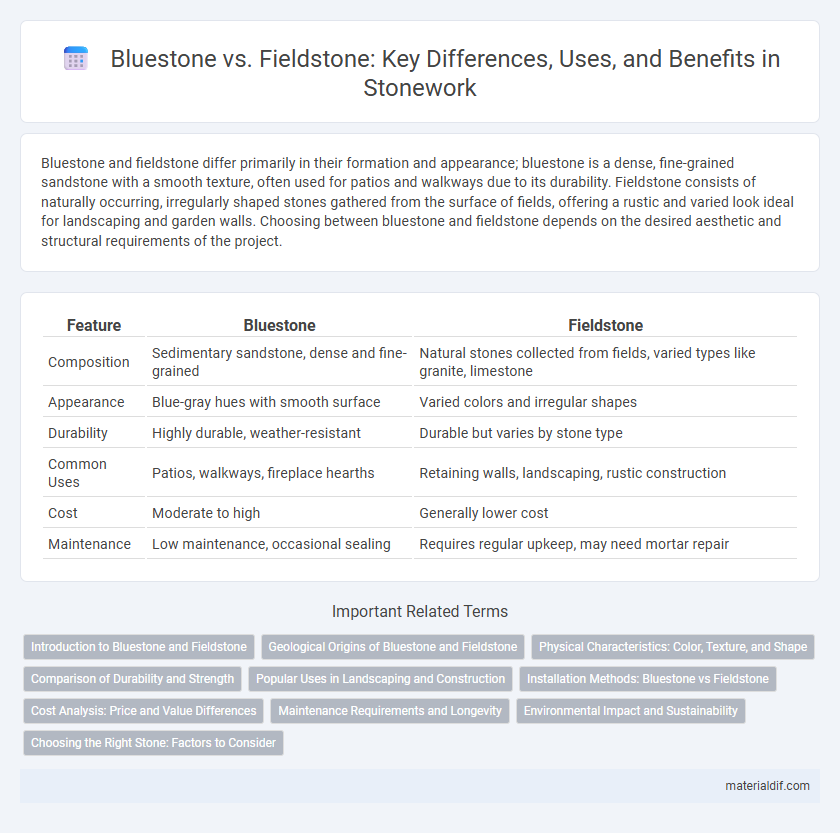Bluestone and fieldstone differ primarily in their formation and appearance; bluestone is a dense, fine-grained sandstone with a smooth texture, often used for patios and walkways due to its durability. Fieldstone consists of naturally occurring, irregularly shaped stones gathered from the surface of fields, offering a rustic and varied look ideal for landscaping and garden walls. Choosing between bluestone and fieldstone depends on the desired aesthetic and structural requirements of the project.
Table of Comparison
| Feature | Bluestone | Fieldstone |
|---|---|---|
| Composition | Sedimentary sandstone, dense and fine-grained | Natural stones collected from fields, varied types like granite, limestone |
| Appearance | Blue-gray hues with smooth surface | Varied colors and irregular shapes |
| Durability | Highly durable, weather-resistant | Durable but varies by stone type |
| Common Uses | Patios, walkways, fireplace hearths | Retaining walls, landscaping, rustic construction |
| Cost | Moderate to high | Generally lower cost |
| Maintenance | Low maintenance, occasional sealing | Requires regular upkeep, may need mortar repair |
Introduction to Bluestone and Fieldstone
Bluestone is a dense, durable sedimentary rock commonly used for patios, walkways, and flooring due to its smooth texture and blue-gray hues. Fieldstone consists of naturally occurring stones collected from fields, characterized by irregular shapes and a variety of colors, ideal for rustic landscaping and retaining walls. Both materials offer unique aesthetic appeal and structural qualities suited for different architectural and landscaping applications.
Geological Origins of Bluestone and Fieldstone
Bluestone primarily originates from sedimentary rock formations such as sandstone and limestone, often found in regions like the northeastern United States, where glacial activity has shaped its distinct blue-gray hue. Fieldstone consists of naturally occurring stones, typically a mix of igneous, metamorphic, and sedimentary types, collected from the surface of fields or glacial deposits and varies widely in composition due to differing geological sources. The geological origin of bluestone emphasizes uniformity in mineral content and sedimentary layering, whereas fieldstone reflects diverse geological processes, including volcanic activity and metamorphism.
Physical Characteristics: Color, Texture, and Shape
Bluestone exhibits a consistent blue-gray color with a smooth, fine-grained texture and uniform rectangular or square shapes, making it ideal for precise landscaping and paving. Fieldstone displays a diverse palette ranging from earthy browns and grays to reds with a coarse, rugged texture and irregular, rounded shapes, lending a natural, rustic aesthetic. The distinct physical characteristics of bluestone and fieldstone influence their suitability for different architectural and landscaping styles.
Comparison of Durability and Strength
Bluestone offers higher durability and compressive strength compared to fieldstone, making it ideal for construction projects requiring long-lasting materials. Fieldstone, though aesthetically appealing with natural irregularities, exhibits variable strength due to its geological diversity and is more prone to weathering over time. Choosing bluestone ensures enhanced resistance to wear and environmental elements, while fieldstone provides a rustic look but may demand more maintenance.
Popular Uses in Landscaping and Construction
Bluestone is commonly used for patios, walkways, and pool coping due to its smooth texture and uniform shape, making it ideal for precise installations. Fieldstone is favored in rustic landscaping features such as garden walls, retaining walls, and natural pathways because of its irregular shapes and rugged appearance. Both types of stone offer durability, but bluestone provides a more polished aesthetic while fieldstone creates a natural, organic look.
Installation Methods: Bluestone vs Fieldstone
Bluestone installation requires precise cutting and leveling to create smooth, uniform surfaces ideal for patios and walkways, often set on a concrete or sand base. Fieldstone installation involves arranging irregularly shaped stones in a more natural, rustic pattern, usually laid directly into mortar or compacted soil for stability. The choice between these methods impacts durability and aesthetic, with bluestone demanding more labor-intensive preparation and fieldstone offering greater flexibility in design.
Cost Analysis: Price and Value Differences
Bluestone typically costs between $8 to $15 per square foot, offering a smooth texture and uniform appearance that appeals to premium landscaping projects. Fieldstone, priced around $5 to $10 per square foot, provides a rustic, natural look at a lower price point, often sourced locally which reduces transportation costs. Evaluating value depends on project requirements: Bluestone's durability and refined finish justify higher investment for formal patios, while fieldstone's affordability and natural aesthetic suit budget-friendly garden pathways.
Maintenance Requirements and Longevity
Bluestone requires regular sealing and occasional cleaning to prevent staining and weathering, while fieldstone's natural rugged texture offers lower maintenance with fewer treatments needed. In terms of longevity, both stones are durable, but bluestone's dense composition withstands wear and moisture better, extending its lifespan significantly in harsh climates. Fieldstone, though resilient, may erode faster due to porous surfaces and exposure to freeze-thaw cycles.
Environmental Impact and Sustainability
Bluestone and fieldstone differ significantly in environmental impact and sustainability; bluestone typically requires quarrying, which can disrupt local ecosystems and generate more carbon emissions, whereas fieldstone is often gathered naturally from surface deposits, minimizing extraction damage. Bluestone's manufacturing processes and transportation contribute to a larger carbon footprint compared to the generally lower-impact, locally sourced fieldstone. Choosing fieldstone supports sustainable landscaping by preserving natural habitats and reducing energy consumption associated with stone processing.
Choosing the Right Stone: Factors to Consider
Bluestone offers a consistent blue-gray color and smooth texture, ideal for elegant patios and walkways, while fieldstone features a natural, rugged appearance with varied shapes and earthy tones perfect for rustic landscaping. Consider durability, aesthetic goals, and installation requirements to select the best stone; bluestone typically requires precise cutting, whereas fieldstone allows flexible fitting. Climate and maintenance needs also influence choice, as bluestone resists harsh weather better, while fieldstone provides superior drainage in garden borders.
Bluestone vs Fieldstone Infographic

 materialdif.com
materialdif.com